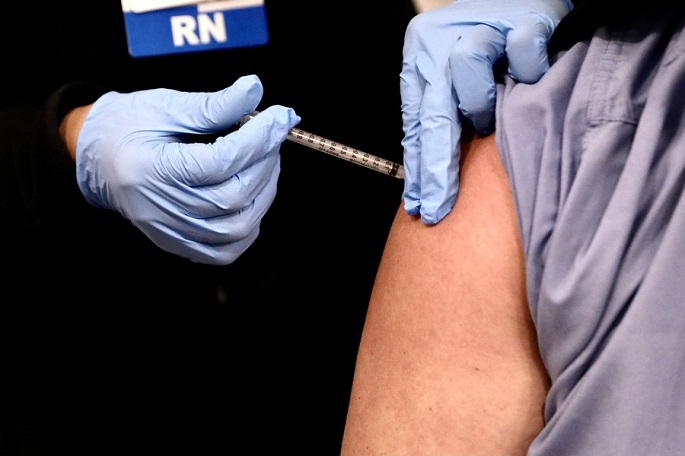US formula means most vulnerable may not get COVID vaccine in time
Published : 23 Dec 2020, 11:15
Even though two types of COVID vaccines have been granted emergency use in the United States and one of them has started to be injected to health care workers, a flawed distribution formula may result in those most vulnerable to the coronavirus unable to get vaccinated in time, reported Xinhua.
The United States has a hierarchical system for vaccination where health care workers are the first in line to be inoculated, but the allocation of vaccines across states is based on the number of adults in each state, meaning health care workers in certain states may end up getting their doses later than those deemed lower priority in other states.
The biggest loser in this flawed scheme is the nation's capital, Washington, D.C., which is able to vaccinate all of its health care workers only until 27.3 million doses have been distributed nationwide.
That compares to Nevada being capable of fully vaccinating their frontline health workers and long-term care residents when the nation dispenses 13.6 million doses, and Massachusetts hitting the threshold once 25.5 million doses are in the hands of state and local authorities, according to an analysis by USA Today.
Complaining about the "one-size-fits-all formula," Washington D.C. Mayor Muriel Bowser sent a letter earlier this month to leaders of Operation Warp Speed, saying the botched plan "will leave the district unable to provide vaccinations to the vast majority of our healthcare workers."
Operation Warp Speed is the Trump administration's public-private partnership initiative for the development and distribution of vaccines.
The mayor's resentment was echoed by at least 14 states last week, according to a New York Times report. The states were frustrated that they got far fewer doses than expected -- 40 percent less in the case of California, the report said.
Moncef Slaoui, the scientific adviser for Operation Warp Speed, told CNN's "State of the Union" on Sunday that the problem was due to a "two-day lag" between confirming that the vaccines that had been produced were safe and knowing that they could be shipped.
Despite those explanations from the practicality point of view, the lack of reason in the distribution plan is, in essence, what concerns many immunization experts.
"I'm shocked that Warp Speed didn't do those calculations" to determine the number of at-risk residents in each state, Peter Pitts, president of the Center for Medicine in the Public Interest and a former associate commissioner at the Food and Drug Administration, was quoted by USA Today as saying.
"It's not rocket science to know what that looks like on a state-by-state basis. It's student intern work ... I just think somebody did not have their eye on the ball," Pitts said.
The Centers for Disease Control and Prevention (CDC) this month issued guidelines urging states to adopt a three-phased vaccination plan. Phase 1a includes health care workers like doctors, nurses, nursing home employees and support staff, as well as long-term care residents.
Phase 1b covers essential workers such as police, firefighters, food workers, teachers and grocery store employees, as well as people older than 75. Phase 1c targets people of ages from 65 to 74, those between 16 and 64 with high-risk medical conditions, as well as other essential workers.
Although estimates show that everyone in phase 1a would be covered when some 20 million doses are available for mass inoculation by the end of the year, the per capita plan will see the shares that 18 states and the District of Columbia get not enough to cover all those in the highest priority group, thus continuing to expose them to the very high possibility of infection.
The issue at center is the scarcity of the vaccine. "This is challenging no matter how you slice and dice it ... There is not going to be enough vaccine in the first rounds," Lori Freeman, chief executive officer of the National Association of County and City Health Officials, was quoted by USA Today as saying.
Freeman said state and local authorities not only have to carry out the national vaccination program without being consulted by the federal government in advance, but also may be blamed for failing to handle the distribution properly. In addition, community health officers were left out of planning for testing and tracing, too.
Tom Bollyky, director of the global health program at the Council on Foreign Relations, warned as early as a month ago that the distribution of vaccines in the United States is going to fall short on the state level.
The first reason Bollyky cited during an interview with the National Public Radio on Nov. 22 is the inadequate resources the CDC has so far promised to states. He said the additional money President-elect Joe Biden has pledged for the distribution "will require congressional action and won't likely happen until February. We're going to need resources sooner."
Secondly, Bollyky pointed directly to the population-based allocation method, whose pitfalls already became apparent when the CDC applied it during the 2009-10 H1N1 pandemic.
"That's the easiest and most politically viable thing to do," he said. "The problem was that states didn't follow the allocation guidelines they'd gotten from the CDC. And what that meant is vaccines went to locally powerful political groups instead of frontline health workers. And we saw significant racial disparities."


